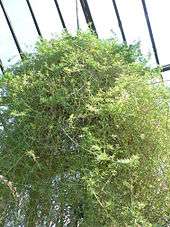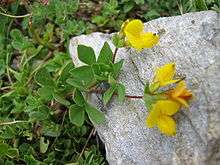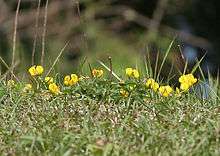Lotus (genus)
| Lotus | |
|---|---|
| | |
| bird's-foot trefoil Lotus corniculatus | |
| Scientific classification | |
| Kingdom: | Plantae |
| (unranked): | Angiosperms |
| (unranked): | Eudicots |
| (unranked): | Rosids |
| Order: | Fabales |
| Family: | Fabaceae |
| Subfamily: | Faboideae |
| Tribe: | Loteae |
| Genus: | Lotus L. |
| Species | |
|
Between 70–150; see text | |
| Synonyms | |
|
Syrmatium | |
Lotus, derived from lota (a small, usually spherical water vessel of brass, copper or plastic used in parts of South Asia), is a genus that includes most bird's-foot trefoils (also known as bacon-and-eggs[1]) and deervetches[2] and contains many dozens of species distributed world-wide. Depending on the taxonomic authority, roughly between 70 and 150 are accepted. Lotus is a genus of legume and its members are adapted to a wide range of habitats, from coastal environments to high altitudes. Most species have leaves with five leaflets; two of these are at the extreme base of the leaf, with the other three at the tip of a naked midrib. This gives the appearance of a pair of large stipules below a "petiole" bearing a trefoil of three leaflets – in fact, the true stipules are minute, soon falling or withering.[3] Some species have pinnate leaves with up to 15 leaflets. The flowers are in clusters of three to ten together at the apex of a stem with some basal leafy bracts; they are pea-flower shaped, usually vivid yellow, but occasionally orange or red. The seeds develop in three or four straight, strongly diverging pods, which together make a shape reminiscent of the diverging toes of a small bird, leading to the common name "bird's-foot".
The genus Lotus is currently undergoing extensive taxonomic revision. All species native to California (30 spp.) have been recently moved to the genera Acmispon and Hosackia in the second edition of The Jepson Manual.
Uses and ecology

Lotus species are used as food plants by the larvae of some Lepidoptera species. Several species are culvivated for forage, including L. corniculatus, L. glaber, and L. pedunculatus. They can produce toxic cyanogenic glycosides which can be potentially toxic to livestock, but also produce tannins, which are a beneficial antibloating compound.
Species in this genus can fix nitrogen from the air courtesy of their root nodules, making them useful as a cover crop. The nodulating symbionts are Bradyrhizobium and Mesorhizobium bacteria. Scientific research for crop improvement and understanding the general biology of the genus is focused on Lotus japonicus, which is currently the subject of a full genome sequencing project, and is considered a model organism.
Some species, such as L. berthelotii from the Canary Islands, are grown as ornamental plants. L. corniculatus is an invasive species in some regions of North America and Australia.
Selected species


- Lotus aboriginus – rosy bird's-foot trefoil
- Lotus aduncus
- Lotus alamosanus – synonym of Hosackia alamosana Rose - Sonora bird's-foot trefoil
- Lotus alpicola
- Lotus alpinus - alpine bird's-foot-trefoil
- Lotus angustifolius
- Lotus angustissimus – slender bird's-foot trefoil
- Lotus anthylloides
- Lotus argophyllus – silver bird's-foot trefoil
- Lotus argyraeus – canyon bird's-foot trefoil
- Lotus australis – austral trefoil
- Lotus benthamii – Bentham's deervetch or Bentham's broom
- Lotus berthelotii – Canary Islands trefoil
- Lotus cedrosensis
- Lotus corniculatus – common bird's-foot trefoil, bird's-foot deervetch
- Lotus crassifolius – big deervetch, Broad-leaved bird's-foot trefoil
- Lotus creticus
- Lotus dendroideus – Island deervetch
- Lotus denticulatus – riverbar bird's-foot trefoil, meadow bird's-foot trefoil
- Lotus glaber – see L. tenuis
- Lotus grandiflorus – chaparral bird's-foot trefoil
- Lotus greenei – Greene's bird's-foot trefoil
- Lotus hamatus – San Diego bird's-foot trefoil
- Lotus haydonii – rock bird's-foot trefoil
- Lotus heermannii – Heermann's bird's-foot trefoil
- Lotus humistratus – foothill deervetch
- Lotus incanus – woolly bird's-foot trefoil
- Lotus intricatus – arid bird's-foot trefoil
- Lotus jacobaeus
- Lotus japonicus
- Lotus junceus – rush deervetch
- Lotus maculatus
- Lotus maritimus
- Lotus mearnsii – Mearns' bird's-foot trefoil
- Lotus micranthus – desert deervetch
- Lotus mollis
- Lotus nevadensis – Nevada bird's-foot trefoil
- Lotus nuttallianus – wire bird's-foot trefoil
- Lotus oblongifolius – streambank bird's-foot trefoil
- Lotus ononopsis
- Lotus ornithopoides
- Lotus palustris
- Lotus parviflorus – smallflower bird's-foot trefoil, smallflower trefoil
- Lotus pinnatus – meadow bird's-foot trefoil, bog bird's-foot trefoil
- Lotus plebeius – New Mexico bird's-foot trefoil
- Lotus procumbens – silky deerweed
- Lotus purshianus – Spanish clover
- Lotus rigidus – desert rock pea, shrubby deervetch
- Lotus rubriflorus – redflower bird's-foot trefoil
- Lotus salsuginosus – coastal bird's-foot trefoil
- Lotus scoparius – common deerweed, common deervetch, California broom, western bird's-foot trefoil
- Lotus sessilifolius
- Lotus stipularis – balsam bird's-foot trefoil
- Lotus strigosus – strigose bird's-foot trefoil
- Lotus subbiflorus – hairy bird's-foot trefoil
- Lotus tenuis – narrowleaf trefoil,[4] narrow-leaved bird's-foot-trefoil[5] slender trefoil, creeping trefoil, or prostrate trefoil
- Lotus tetragonolobus – winged bird's-foot trefoil
- Lotus unifoliolatus – American bird's-foot trefoil
- Lotus pedunculatus – greater bird's-foot trefoil, marsh bird's-foot trefoil, large bird's-foot trefoil, big trefoil; formerly L. uliginosus.
- Lotus utahensis – Utah bird's-foot trefoil
- Lotus wrangelianus – Chilean bird's-foot trefoil
- Lotus wrightii – Wright's deervetch
- Lotus yollabolliensis – Yolla Bolly bird's-foot trefoil
References
- ↑ Collins English Dictionary
- ↑ See Acmispon
- ↑ C. A. Stace, Interactive Flora of the British Isles, a Digital Encyclopaedia: Lotus. ISBN 90-75000-69-3. (Online version)
- ↑ "Lotus tenuis". Natural Resources Conservation Service PLANTS Database. USDA. Retrieved 27 January 2016.
- ↑ Lotus tenuis, ITIS report
External links
| Wikimedia Commons has media related to Lotus. |

